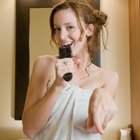
A hug is a mutual act of love and affection that induces feelings of comfort, contentment and security. Hugs are great because they don't cost anything, don't require any words and are incapable of causing harm. Humans require physical contact to survive, particularly young children. A really good hug makes you feel great, but what constitutes a proper hug depends on the relationship between the huggers. Embracing your child, for instance, is very different from cuddling your partner.
Romantic Hug
Step 1
Step toward your partner and slip your left arm between his right arm and the side of his body. Position your left hand on his lower back, just above his backside, suggests "Glamour" magazine.
Step 2
Raise your right arm and gently hold the back of his neck, placing your thumb along the side of the neck. Draw your head toward his right shoulder. Rest your chin lightly on his shoulder, if you are tall enough. Otherwise, lean the side of your head against his chest.
Step 3
Hold the hug for a few seconds. Press your lower body against his if you want your hug to have a little extra friction.
Friendly Hug
Step 1
Walk toward your friend with you arms stretched out in front of you; your friend will do the same. Position your arms above your friends' arms if you are the taller person, below them if you are the shorter.
Step 2
Decide whether your arms are going higher or lower than your friend's if you are the same height: as the instigator of the hug -- it's your call, says Simon Sidney, author of "Caring, Feeling, Touching." Place your arms around your friend's body and pull her toward you.
Step 3
Hold the hugging position as long as you sense is appropriate. This depends on how close your friendship is and the circumstances under which you are hugging, says Sidney. If your friend has just told you some great news, or you have not seen each other for a long time, for example, you may want to tighten your arms around the person and hold the hug for several seconds.
Male-to-Male Hug
Step 1
Extend your arms, positioning the right arm higher than the left; your friend will do the same. Place your right arm over your friend's shoulder and your left arm around his waist.
Step 2
Clap your friend's back with one or both hands, whatever feels comfortable. Keep the rest of your body a couple of inches away from his.
Step 3
Stay in position. Continue the clapping for a few seconds.
Comforting Hug
Step 1
Rest your hands on the other person's shoulders and pull her close to you. Wrap your arms around her upper body.
Step 2
Place one of your hands up to the back of the other person's head and gently draw it forward. Depending on your height difference, says Sidney, she will be able to bury her face in your bosom or rest it on your shoulder.
Step 3
Squeeze your arms around the other person and hold the hug for several seconds - or longer, if a great deal of comfort is to be provided. Sidney suggests varying this type of hug by standing behind the other person, linking your hands around her stomach or shoulders and placing your cheek gently against hers.
Related Articles

Decoding a Man's Hug

How to Measure Human Torso Length

How to Size Compression Shorts

How to Wrap a Towel Around the Body

How to Tie a Male Sarong

How to Connect Corsets to Stockings

How to Tie a Fundoshi

How to Put on a Stola & Palla

How to Put on Fishnet Stockings

Posture & Nonverbal Communication

How to Determine the Proper Sleeve ...

How to Give a Sensual Massage to a Woman

How to Clean Your New (Conch) Ear ...

How to Wear a Short Scarf Around the ...

How to Tie a Kimono Belt for a Man

How to Hang Sweaters So They Don't Get ...

Nonverbal Signs of Romantic Attraction

Male Gestures That Indicate He Is ...

How to Tie a Navy Neckerchief

How to Find the Correct Bra Size
References
- Glamour: How to Give Him a Hug That Tells Him You Want to Be More Than Friends
- Caring, Feeling, Touching; Simon Sidney
Resources
Writer Bio
C. Giles is a writer with an MA (Hons) in English literature and a post-graduate diploma in law. Her work has been published in several publications, both online and offline, including "The Herald," "The Big Issue" and "Daily Record."
Photo Credits
Visage/Stockbyte/Getty Images